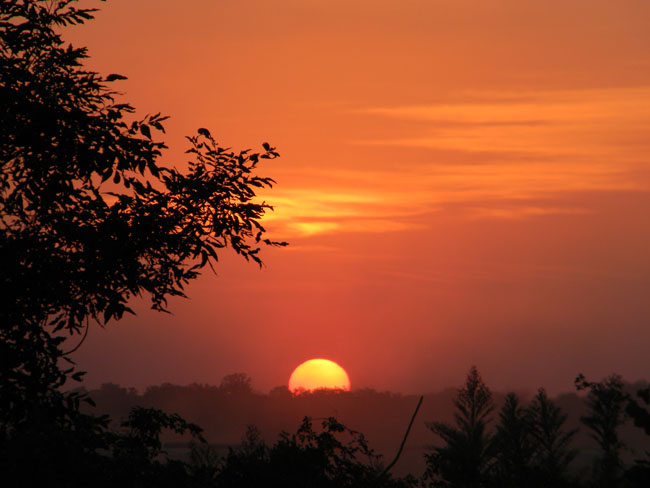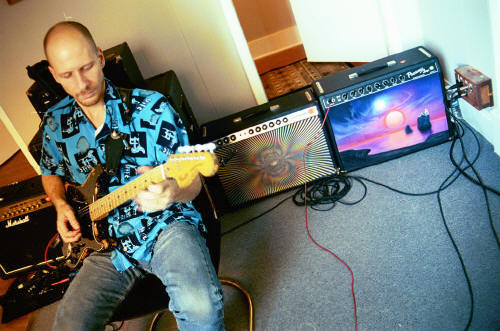Clarksdale, Mississippi – Verse Three and Outro
Saturday Morning at the Shack Up Inn
We woke up kind of late on Saturday morning, a light rain falling on this grey but warm September day. Although we had initially planned to check out and head to Memphis around noon, we felt like our journey here wasn’t complete and that we would be doing ourselves an injustice by not staying for one more day. Memphis would just have to wait for another time. So after a little breakfast on the screened in back porch, I walked over to the lobby to see if we could stay for one more night. I explained to Marc, the woman working at the front desk, that we were having such a great time in Clarksdale and wanted to stay for one more night. “All our shacks are booked for tonight, but give me a moment.” With that, she disappeared into a back room, returning a moment later with some good news. 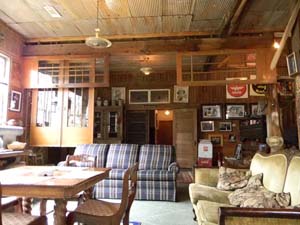 “Guy said that we can rent you a room at ‘Bill’s house’ if that can work for you.” “Sure, that sounds good.” A minute later, I was introduced to Guy who walked me over to the house to show me the set up.
“Guy said that we can rent you a room at ‘Bill’s house’ if that can work for you.” “Sure, that sounds good.” A minute later, I was introduced to Guy who walked me over to the house to show me the set up.
As it turned out, ‘Bill’s House’ is a magnificent 3000 square foot, three bedroom ‘cabin style’ home housed in an old tin covered barnlike structure just beyond the shacks. The decor in this giant space was as rustic as our cabin, and our bedroom even had its own separate bathroom wing. I told Guy that this would work just fine, and on our walk back over to the lobby asked him if they ever have any performances in the music hall. “Yeah, we have live music sometimes. It’s actually a great sounding room. I’m working towards being able to make live recordings in there.” He went on to tell me how when they were first building the music room, he had a friend from a university come in and conduct ‘sound tests’ to acoustically maximize the space. If all goes as planned the Shack Up Inn will have the ability to make live multitrack recordings sometime in the spring of 2011. I said goodbye to Guy and headed back to our shack to begin moving our belongings over to ‘Bill’s House’.
A Drive around Town
After lunch we decided to take another drive around to further explore the town. As we had already seen much of downtown, we set out without a plan to get a feel for some parts of the town we had not yet seen. The city of Clarksdale is an interesting community. Our casual  drive encountered sporadic light traffic, and took us in and out of many different neighborhoods. There were ‘nice’ sections, and not so nice sections, but even driving through the not so nice sections, we never once felt uncomfortable. We noticed some areas had relatively well maintained homes right next to rundown ‘shack like’ buildings, while other areas looked completely destitute. Economically speaking, Mississippi is
drive encountered sporadic light traffic, and took us in and out of many different neighborhoods. There were ‘nice’ sections, and not so nice sections, but even driving through the not so nice sections, we never once felt uncomfortable. We noticed some areas had relatively well maintained homes right next to rundown ‘shack like’ buildings, while other areas looked completely destitute. Economically speaking, Mississippi is 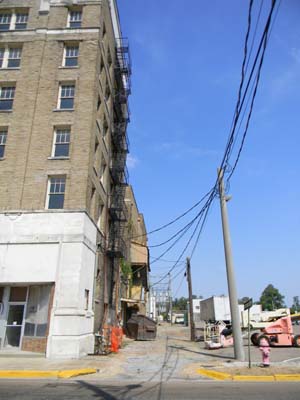 the poorest state in America, and this struggle was evident. How could a place so rich in culture and history, it’s musical heritage literally the foundation of all modern music, become so neglected and forgotten?
the poorest state in America, and this struggle was evident. How could a place so rich in culture and history, it’s musical heritage literally the foundation of all modern music, become so neglected and forgotten?
A little while later we were driving by Red’s on the way back to the Inn when I noticed a car parked out front. The front door was open, so I stopped in for a quick hello. During our brief chat Red asked me where I was from. “We’re from Nashville and came here to celebrate Kelly’s birthday.” “Nashville, now that’s a dangerous place!” he proclaimed, and I nodded my head in agreement. He went on to tell about some of the town’s biggest talents growing up within just a few miles of this spot. “John Lee Hooker grew up just a couple miles from here. Muddy Waters grew up about 5 miles from here. Ike Turner used to live right across that bridge.” He went on to tell about how in the old days, when a lot of these guys started becoming successful, that’s when their problems really began. “Once they started making money, they bought new houses and cars, only to lose it all once they split up with their old ladies. Sometimes, after they’d become successful, they couldn’t afford to have careers, so they’d just quit for a while.” So goes the life of a bluesman.
Saturday Dusk at the Inn
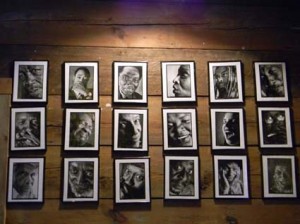 We returned to our ‘new shack’ and ate dinner, after which I decided to take one more walk around for some photos. The music room in the ‘Cotton Gin’ contains some beautiful spectacles, and I just stood there for a moment upon entering, soaking in its woody vibe. Memorabilia and signs from a forgotten era in the South’s not so distant past were constantly evident, and at times I couldn’t tell whether I was standing in a music hall or some sort of cultural exposé. The fact that blues recordings can be heard literally all over this plantation only add to the mystique. A sign bearing the words ‘Dentons Ice Cream – it’s real food’, a portrait of Elvis, a pre-1950s looking Schlitz beer sign, an old Coke machine – not a hint of anything modern except for the two PA speakers on the stage. I was beginning to feel like this entire Clarksdale experience was the junior high school field trip that I never had, but should have had. This kind of culture and history just can’t be learned in a textbook.
We returned to our ‘new shack’ and ate dinner, after which I decided to take one more walk around for some photos. The music room in the ‘Cotton Gin’ contains some beautiful spectacles, and I just stood there for a moment upon entering, soaking in its woody vibe. Memorabilia and signs from a forgotten era in the South’s not so distant past were constantly evident, and at times I couldn’t tell whether I was standing in a music hall or some sort of cultural exposé. The fact that blues recordings can be heard literally all over this plantation only add to the mystique. A sign bearing the words ‘Dentons Ice Cream – it’s real food’, a portrait of Elvis, a pre-1950s looking Schlitz beer sign, an old Coke machine – not a hint of anything modern except for the two PA speakers on the stage. I was beginning to feel like this entire Clarksdale experience was the junior high school field trip that I never had, but should have had. This kind of culture and history just can’t be learned in a textbook.
Red’s blues party with T-Model Ford and friends
It was about 7:30 when we pulled up to Red’s and, unlike the night before, the place already had a bit of a crowd. We walked in toting my guitar and amp, as Red requested, set them down near the music area and found a seat. T-Model was already there, sitting on a chair next to the drums and lightly playing some bluesy guitar riffs. His 12-year-old grandson ‘Stud’ is T-models regular drummer, and was already seated behind the drums. I went to the bar to say hi to Red, bought a couple of beers and returned to the table. A few minutes later T-Models light strumming morphed into the beginning of his set, almost unnoticed. The crowd grew quiet as soon as he began singing in his deep resonant voice, his chilling cries slicing through the night air like a razor. We sat mesmerized, and the crowd showed appreciation after each song. About a half hour into his set he asked “Where’s that other gee-tar man?” I raised my hand, and he waved me to the stage with an inviting gesture.
As soon as I set up my amp and plugged in my guitar we were off and running. He never announced any song in advance, he would just start playing a rhythm, a couple of bars later Stud would follow suit, and I would jump in as soon as I could figure out what they were doing. Before I knew it, the place was a rockin’ and I was holding on for dear life. Every once in a while, in between songs, T-Model would grab a glass of whiskey from the top of his amp, hold it up, and proclaim with a passionate howl “Jack Daniels time!” evoking an excited response from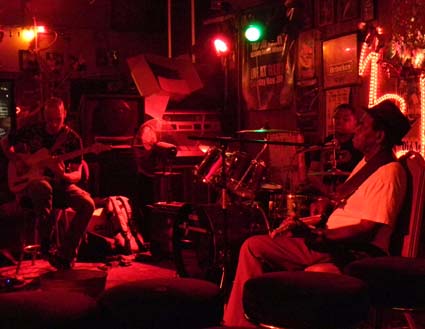 the crowd every time. Beginning to feel a little left out, I signaled Kelly to bring me a glass of whiskey, which, after taking a healthy swig from, I set on a stool beside me. Gradually, the place filled up and we just kept on playing. I recognized some of the faces from the night before, but many newcomers were there as well. When T-Model asked the crowd were they were all from, some of the answers were different than the night before, but still just as diverse – Wisconsin, Spain, Louisiana, Germany, among other distant places.
the crowd every time. Beginning to feel a little left out, I signaled Kelly to bring me a glass of whiskey, which, after taking a healthy swig from, I set on a stool beside me. Gradually, the place filled up and we just kept on playing. I recognized some of the faces from the night before, but many newcomers were there as well. When T-Model asked the crowd were they were all from, some of the answers were different than the night before, but still just as diverse – Wisconsin, Spain, Louisiana, Germany, among other distant places.
Following T-Model in his unique brand of Delta blues was as much an education as anything else. Unique to his style is a peculiar notion of changing chords on random beats, something that Stud is exceptional at following, and I was learning. This required intense concentration on my part, and I rarely took my eyes off of T. Apparently, it was all working quite well, as the audience constantly showed their approval. Several times throughout the night the dance floor again erupted with the kind of sexy and provocative moves that could only happen in a juke joint in the deep South. At some point in the middle of all this, Dingo asked if ‘Gypsy’, the blues guitarist from Japan, could use my amp for a couple of songs. He played a couple, and then T-Model motioned to me back to the stage. A local harp player then sat in for a few, the crowd still grooving hard. Around 11:30 things began to wind down, T-Model had been playing for nearly 3 1/2 hours straight and it seemed like he had said everything that needed to be said.
As I put my gear away, I couldn’t help but thinking how lucky I was to be invited to play a whole night with a living blues legend in a real juke joint. We had a few photos taken with Red and the gang, and thanked everybody for making our first trip to Clarksdale such a wonderful experience. I commented to Dingo about how great it was that they let other players sit in. “We let everybody play. If they’re good, then they can keep on playing. If they’re not too good, then we just kinda eeeeease em’ on out after a couple of songs. But everybody gets to play at Red’s.” I thanked T-Model for letting me play, and he shook my hand and said “Thank You!” Red and his friends had welcomed us into their world, and their openness warmed our souls. It was a truly magical night!
Nightcap at the Shack
Back at the Shack Up Inn a few minutes later, we grabbed a couple of beers and went out to sit on the giant porch swing behind the lobby to unwind. We chatted with several other visitors, and it seemed everybody we talked to had been at Red’s at some point over the weekend. College kids from LSU, a couple vacationing from San Francisco, even Marc, the front desk clerk had gathered with us to enjoy some late-night cheer. It wasn’t long before some acoustic guitars came out, and we all sat around for a little while longer strumming and singing into the night. I couldn’t believe that we were actually going to have to leave this place!
Clarksdale, Mississippi – Verse Two and Chorus
Friday Morning at the Shack Up Inn
Friday morning came a little too early when we were awoken by some sort of tweety bird chirping right outside our bedroom window 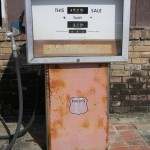 around 7 AM. With the help of some earplugs, we were able to fall back asleep for a couple more hours with hardly a sound from the outside world audible from inside our little shack. After eating some breakfast while listening to a little Robert Johnson, I decided to go on a photo taking expedition around the grounds. It might not be right for everyone, but I found the decor around the Shack Up Inn immensely interesting. Rusted old farm equipment decorated the lawn, old Coca-Cola signs were placed at random, a tree was covered with blue and green bottles – these folks had figured out how to turn what might otherwise be considered junk into art, and this helped make the Inn feel like some sort of living
around 7 AM. With the help of some earplugs, we were able to fall back asleep for a couple more hours with hardly a sound from the outside world audible from inside our little shack. After eating some breakfast while listening to a little Robert Johnson, I decided to go on a photo taking expedition around the grounds. It might not be right for everyone, but I found the decor around the Shack Up Inn immensely interesting. Rusted old farm equipment decorated the lawn, old Coca-Cola signs were placed at random, a tree was covered with blue and green bottles – these folks had figured out how to turn what might otherwise be considered junk into art, and this helped make the Inn feel like some sort of living 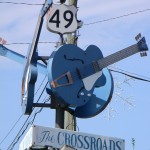 museum of the old American South.
museum of the old American South.
We set out a little while later to begin exploring downtown, and our first stop was to take a few photos of the ‘crossroads’ sign at Highway 49. The picture in my mind of this place where Robert Johnson allegedly made his deal with the devil is of course nothing like this modern touristy version, as this intersection is now surrounded with businesses including the adjacent Churches Chicken. It was still worth a few pictures, and later in the day I accidentally found another intersection in town that looked eerily like the crossroads I envisioned.
Downtown Clarksdale
As we continued driving towards downtown we began to notice how poor this community is, seeing many run down buildings, once occupied by businesses and services, now empty, their exteriors slowly deteriorating. Upon arriving downtown we easily found a free parking spot near the Delta Blues Museum and began our first walk around amidst some light foot traffic. Our first stop would be Blues 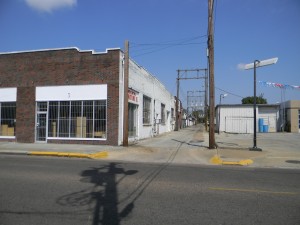 Town Music, a local music store filled with cool old gear, worthy of the store’s namesake. An Asian man was sitting on a stool and playing some traditional blues on an open tuned guitar – “I saw you play at Ground Zero last night. Great playing!” he commented. “Thanks. I’m Eric, pleased to meet you.” “My name is Gypsy, and I’m here on vacation from Japan.” he informed me, and after some conversation I learned this was his 10th trip to Clarksdale. We continued our stroll, taking in the sights of this obviously once booming town, now struggling for its very survival. The downtown area had pockets of activity, and other areas that seemed void of all life. Many of the buildings looked like they hadn’t been painted in decades, some with boards on the windows, others with bars on them. As we continued our walk on some of these near empty streets, this kind of sporadic hot and cold ghost town feeling was almost a bit unnerving, however, not once did we feel in danger.
Town Music, a local music store filled with cool old gear, worthy of the store’s namesake. An Asian man was sitting on a stool and playing some traditional blues on an open tuned guitar – “I saw you play at Ground Zero last night. Great playing!” he commented. “Thanks. I’m Eric, pleased to meet you.” “My name is Gypsy, and I’m here on vacation from Japan.” he informed me, and after some conversation I learned this was his 10th trip to Clarksdale. We continued our stroll, taking in the sights of this obviously once booming town, now struggling for its very survival. The downtown area had pockets of activity, and other areas that seemed void of all life. Many of the buildings looked like they hadn’t been painted in decades, some with boards on the windows, others with bars on them. As we continued our walk on some of these near empty streets, this kind of sporadic hot and cold ghost town feeling was almost a bit unnerving, however, not once did we feel in danger.
We walked over to the Ground Zero Blues Club to snap a couple of quick pictures in the daylight, and continued onward in search of the legendary ‘Red’s Blues Club’, the infamous juke joint everyone seemed to hold in such high regard and our destination for later that night. Coming out the back side of the Ground Zero parking lot we came to a large abandoned blue brick building touting the sign ‘Delta Wholesale Hardware Co.’ before crossing the train tracks. A little further down the road we spotted another old brick building with a couple of smokers sitting on the curb in front. Somehow we just knew this was Red’s and ventured closer to take a peek. If you didn’t know what you were looking for you would never think to stop at this Sanford and Sonesque place, it’s curb littered with a beat up old couch, a broken toilet, and several large pieces of homemade barbecue apparatus. Above a tattered old canopy the faded words  ‘LaVENE MUSIC CENTER’ were stenciled onto the brick, perhaps remnants of another failed business out of yesteryear. Only once right upon the sidewalk did the sign ‘Red’s Blues Club’ become visible. It was a curious moment of realization knowing that a few hours later we would likely be experiencing something very unique and special.
‘LaVENE MUSIC CENTER’ were stenciled onto the brick, perhaps remnants of another failed business out of yesteryear. Only once right upon the sidewalk did the sign ‘Red’s Blues Club’ become visible. It was a curious moment of realization knowing that a few hours later we would likely be experiencing something very unique and special.
We began walking back to our car to return to the shack for some lunch when a friendly local volunteered to take our picture. For a split second we both had the vision of the scene in National Lampoon’s ‘European Vacation’ when a local runs off with the tourists camera, but that didn’t happen, this local was quite genuine.
Cat Head Delta Blues and Folk Art
Upon returning downtown a couple of hours later our first stop would be at 252 Delta Ave, home of Cat Head Delta Blues and Folk Art. The place was kind of a cross between a gift shop and an art gallery for blues aficionados containing CDs, DVDs, books, T-shirts, and some amazing local folk Art. They had a large collection of documentaries and books about blues history and culture available and I could have easily spent a small fortune. Not having grown up in the South, I asked the man behind the counter about the origins of the term ‘Cat Head’. He explained to me that “In the early 1900’s ‘Cat Head’ was a company that made giant biscuits, biscuits so large they were the size of a cat head.” In addition to being a store selling everything related to the blues, Cat Heads website is kind of a central gathering point for information pertaining to not just Clarksdale’s live music scene and points of interest, but to blues related events throughout the Delta. After browsing the store for a little while longer while listening to some obscure blues recordings over the speakers, we went on down the road.
Located on East Second Street, (a little bit off the beaten path) we found our way into the museum and were greeted by ‘Theo’. Theo is originally from Europe and the owner of the museum and, above all else, Theo loves American blues music, history, and culture. After paying the minimal entry fee of five dollars a head, well worth every penny mind you (not to mention helping this great nonprofit organization), we began exploring this massive collection of American roots music culture. “Roots to Fruits”, Theo explained, is the theme of this museum, and if you walk through the museum on the recommended path, it shows the evolution of the earliest blues artists and recordings, and how that music transcended across generations and continents giving birth to early blues influenced rock and roll artists like Elvis, the Beatles, and the Stones before morphing into the roots of modern rock with artists like Jimi Hendrix, Led Zeppelin, the Who, and beyond. Amidst this collection of rarities, which I learned was moved here from Europe about five years ago, were some of the earliest and rarest blues records, concert posters, early record players and jukeboxes, even an old barber chair that came from a local barber shop in which John Lee Hooker and many other legends got haircuts back in the day. We saw the Muddy Waters record which gave birth to the Rolling Stones namesake, its title bearing ‘Rolling Stone’. The original contract offer form for the Who’s performance at Woodstock, where they received $6250.00 for their historic performance. Pencil drawings by John Lennon, the controversial Jimi Hendrix ‘Electric Lady Land’ album sleeve bearing several nude ladies, and Muddy Water’s ‘contract rider’. We could’ve stayed in there all day, and this would have been especially easy to do as Theo loves to talk, but we said goodbye as we still needed to check out the Delta Blues Museum.
This nonprofit museum is also a must see for anyone who wants to learn more about American blues culture. We arrived a bit late in the day, only about 45 minutes before closing, so we had to breeze through a little faster than we might have preferred. However, the 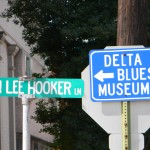 place is magnificent. Early blues recordings can be heard playing over the loudspeakers upon entering the lobby. After we paid our entrance fee of seven dollars each, we walked into a giant room that seemed to radiate from another era. The walls were covered with records, plaques, and drawings of blues legends that came from this part of the Delta. Guitars, clothing, and other memorabilia from artists like Charlie Patten, Son House, Ike Turner, and countless others who had grown up within a few miles of this place were beautifully displayed within plexiglass cases. Perhaps the deepest moment of experience we had within this giant roomful of blues was the Muddy Waters exhibit. The original sharecropper shack in which Muddy Waters grew up had been placed inside this room, complete with one of his old Fender Twin amplifiers, and a legendary guitar commissioned for the museum by Billy Gibbons that had been built from one of the pieces of wood from this shack. Inside the shack, videos showed archival footage of Muddy as well as interviews with his peers, all to a soundtrack of his rootsy music. The moment was revealing knowing the hard life this man must have endured, growing up with his family in such a small coarse space in pre-civil-rights America. It was difficult to pull ourselves away, and we gradually made our exodus as the museum was about to close.
place is magnificent. Early blues recordings can be heard playing over the loudspeakers upon entering the lobby. After we paid our entrance fee of seven dollars each, we walked into a giant room that seemed to radiate from another era. The walls were covered with records, plaques, and drawings of blues legends that came from this part of the Delta. Guitars, clothing, and other memorabilia from artists like Charlie Patten, Son House, Ike Turner, and countless others who had grown up within a few miles of this place were beautifully displayed within plexiglass cases. Perhaps the deepest moment of experience we had within this giant roomful of blues was the Muddy Waters exhibit. The original sharecropper shack in which Muddy Waters grew up had been placed inside this room, complete with one of his old Fender Twin amplifiers, and a legendary guitar commissioned for the museum by Billy Gibbons that had been built from one of the pieces of wood from this shack. Inside the shack, videos showed archival footage of Muddy as well as interviews with his peers, all to a soundtrack of his rootsy music. The moment was revealing knowing the hard life this man must have endured, growing up with his family in such a small coarse space in pre-civil-rights America. It was difficult to pull ourselves away, and we gradually made our exodus as the museum was about to close.
The Crossroads
Having thoroughly explored the streets and sites of this unique downtown during the daylight hours, we returned to our shack for dinner and a shower, anxious for our second nighttime adventure into this land of the blues. I had noticed earlier in the day that the intersection of the road leading into the Shack Up Inn, especially from one particular angle, looked a bit like the crossroads of the Robert Johnson era that I had many times pictured in my mind. So right before dinner, with the sun low in the western sky, I snapped a few photos to see if I could capture the unique feeling of standing at such a foreboding spot out of American folklore. A little while later I couldn’t help but to experiment with my picture in Photoshop, and with a few quick adjustments, I had a photo that, at least to me, looked like ‘the crossroads’ where Robert might have made his deal.
Red’s Blues Club
We arrived at Red’s just after 9:00 PM and ‘Big Anthony’ was getting ready to play. The place was still near empty and, after paying a five dollar cover charge, we found a seat and began to take in the sultry scene. Red was working behind the bar and sporting a pair of dark sunglasses in an already dimly lit room. I’m not sure if it’s intentional or not, but the lighting in Red’s is just that – red. Red colored 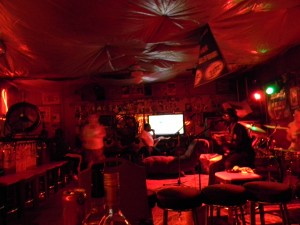 neon signs scattered throughout and a couple of red colored lights aimed at the stage create a kind of reddish hue that was inescapable. The place was fairly small, about 20 x 40, and sheets of plastic haphazardly covered the ceiling. Every square inch of the walls was covered with something, be it photos, posters, beer signs, or the lone flat screen TV which never went off. The place had 2 air conditioners which occupied the only windows in the place and a series of fans placed strategically (or randomly) at different locations throughout. The furnishings were comprised of several varieties of barstools, tables, chairs, and couches, all mis-matched and old looking, yet amazingly comfortable. The performance area faced the bar, and its central location seemed to optimize the room. On either side of the ‘stage’ stood a giant column of four or five speakers, circa 1980’s, although it only seemed like a couple of them were being used.
neon signs scattered throughout and a couple of red colored lights aimed at the stage create a kind of reddish hue that was inescapable. The place was fairly small, about 20 x 40, and sheets of plastic haphazardly covered the ceiling. Every square inch of the walls was covered with something, be it photos, posters, beer signs, or the lone flat screen TV which never went off. The place had 2 air conditioners which occupied the only windows in the place and a series of fans placed strategically (or randomly) at different locations throughout. The furnishings were comprised of several varieties of barstools, tables, chairs, and couches, all mis-matched and old looking, yet amazingly comfortable. The performance area faced the bar, and its central location seemed to optimize the room. On either side of the ‘stage’ stood a giant column of four or five speakers, circa 1980’s, although it only seemed like a couple of them were being used.
Anthony spotted me from across the room and made his way over asking “Did you bring a guitar?” “Yeah, but I came to hear you play. I’ll get it in a little while.” A few minutes later a friendly older gentleman, who seemed to know everybody, walked on over to our table and said “I’m going to sit with you folks tonight, if that’s okay.” “Of course, have a seat.” I said, later learning his name to be Dingo. We ordered a couple of beers and set our bottle of tequila on the table next to Dhingo’s bottle of Evan Williams whiskey. Beer is the only alcohol sold at Reds, therefore allowing a BYOB for liquor only.
Anthony’s show began as perhaps the most subtle start to a performance I have ever seen. Also wearing sunglasses, “A” was sitting on a stool with a cigarette hanging out of his mouth when he began playing some blues guitar licks, backed only by a drummer. There were maybe only six or eight of us in the room at this point, and the feeling was relaxed and comfortable as Anthony played his brand of  Delta blues. He must have played seven or eight blues instrumentals, for nearly an hour, before the vocal portion of his night would begin. The music was earthy and hypnotic and it felt as if time had stood still. As his deep voice resonated some mournful passages, I felt transported to another era. Gradually the night picked up and people started coming in. Another local sat in on backup vocals for a couple of songs, and then Dingo was up to sing a little too. The dance floor (or carpeted area in front of the band) had a few eruptions of activity throughout the night whenever locals and tourists felt the mood. At one point Anthony asked different folks around the room where they were from. The answers were as diverse as imaginable – Italy, Canada, Switzerland, New Orleans, Japan, San Francisco, Tennessee, Australia – people from all over somehow knew about this hidden blues universe.
Delta blues. He must have played seven or eight blues instrumentals, for nearly an hour, before the vocal portion of his night would begin. The music was earthy and hypnotic and it felt as if time had stood still. As his deep voice resonated some mournful passages, I felt transported to another era. Gradually the night picked up and people started coming in. Another local sat in on backup vocals for a couple of songs, and then Dingo was up to sing a little too. The dance floor (or carpeted area in front of the band) had a few eruptions of activity throughout the night whenever locals and tourists felt the mood. At one point Anthony asked different folks around the room where they were from. The answers were as diverse as imaginable – Italy, Canada, Switzerland, New Orleans, Japan, San Francisco, Tennessee, Australia – people from all over somehow knew about this hidden blues universe.
Now pretty far into this evening and feeling fine, I asked Anthony between songs if I could play a couple with him. He nodded yes, so I went out and grabbed my guitar and amp. I joined him and his band of drummer ‘the Clarksdale All-Stars’ for two or three up-tempo blues, a high point coming on the last song with a little ‘head cutting’. Already having played two and a half hours straight, Anthony suggested I sing a couple while he took a break. His drummer stayed on and I played a couple of blues classics before launching into a funky version of Hendrix’s ‘Voodoo Child’ which received a roaring applause. I returned to the stage to Anthony, and a little while later when we were getting ready to leave, Red made his introduction. “You should come back tomorrow night, ‘T-Model Ford’ will be here and it’s gonna’ be a good time. Bring your guitar too. The old guys don’t mind other musicians playing with them.” “Were supposed to go to Memphis tomorrow, but if we can rent our room for one more night we just might do that. Are you sure it would be okay for me to play with him?” I asked. “This is my place, just come on down and bring your guitar.” I then grabbed the unopened bottle of Evan Williams, Red’s whiskey of choice, from the back of my amp and presented it to Red. “We read on the Internet that this is your favorite whiskey, so we brought you a bottle as our way of saying thanks.”
With that, we headed back to the shack. Having had such an amazing experience so far, the idea of leaving for Memphis in the morning was growing less likely by the minute. 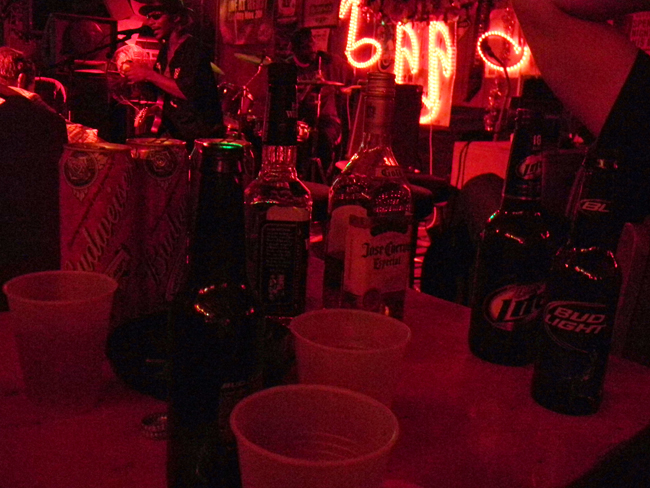
Clarksdale, Mississippi – Intro and Verse One
The Drive
It was noon on Thursday, September 23 when we left our Pegram, TN home bound for Clarksdale, Mississippi. Our route took us west on Interstate 40 for about 200 miles to Memphis, and while this stretch of I-40 is typically a rather boring drive, on this hot summer day, whatever was lacking in visual stimulation was replaced with anticipation. Although we had done a fair amount of research, we still didn’t know exactly what to expect in Clarksdale, so our excited conversations ultimately kept us from noticing that the scenery out the car window hadn’t changed much for the first three hours of the trip.
At Memphis we turned south onto Interstate 55 and entered Mississippi, and while the first hour of I-55 wasn’t anything visually 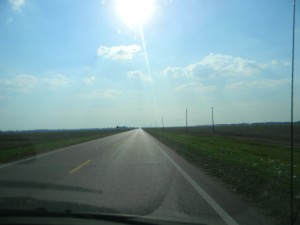 extraordinary, as soon as we turned west on to Highway 278 it felt like we entered a new world. The dense forest that had occupied both sides of the road only minutes before vanished to reveal a wide open view of the Delta plane. Cotton fields stretching to the horizon, cut in two by the road on which we traveled, a seemi
extraordinary, as soon as we turned west on to Highway 278 it felt like we entered a new world. The dense forest that had occupied both sides of the road only minutes before vanished to reveal a wide open view of the Delta plane. Cotton fields stretching to the horizon, cut in two by the road on which we traveled, a seemi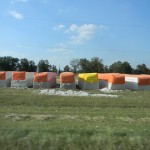 ngly endless road, straight, flat, and disappearing as far into the distance as the eye could see. Aside from other vehicles on the highway, the occasional farmhouse, and farm equipment sparsely scattered throughout the fields, the vastness of this geography was otherworldly. Although this last 40 or so miles was the shortest leg of the drive, our virgin viewing of this fertile Delta plane was empowering and made us feel a bit the wiser, almost as if we were the first explorers to set foot upon a newly discovered continent.
ngly endless road, straight, flat, and disappearing as far into the distance as the eye could see. Aside from other vehicles on the highway, the occasional farmhouse, and farm equipment sparsely scattered throughout the fields, the vastness of this geography was otherworldly. Although this last 40 or so miles was the shortest leg of the drive, our virgin viewing of this fertile Delta plane was empowering and made us feel a bit the wiser, almost as if we were the first explorers to set foot upon a newly discovered continent.
The Shack Up Inn and The Robert Clay Shack
Upon entering Clarksdale, located in Coahoma County, Mississippi, we turned south onto Highway 49 for a couple of miles and found 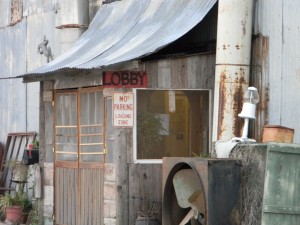 our way to the Hopson Plantation and the location of the place we would be staying, The Shack Up Inn. As we crossed over some railroad tracks, several old ‘barn-like’ buildings covered with rusty corrugated tin came into view, and we passed a row of shacks as we began searching for the lobby. At first glance the main entrance appeared to be a cross between an antique store and a junkyard, and if
our way to the Hopson Plantation and the location of the place we would be staying, The Shack Up Inn. As we crossed over some railroad tracks, several old ‘barn-like’ buildings covered with rusty corrugated tin came into view, and we passed a row of shacks as we began searching for the lobby. At first glance the main entrance appeared to be a cross between an antique store and a junkyard, and if 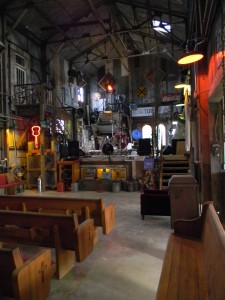 it were not for a small red sign bearing the hand-painted word ‘lobby’, we might have driven right by. We were greeted warmly by Marc, the woman working at the front desk, and she checked us in while giving us a quick overview of the Inn and some other local attractions. The main lobby is housed within an enormous ‘cotton gin’, and on the other side of the lobby walls the large open space has been transformed into a music hall. After checking in we took a few moments to explore this magnificent room which featured a stage at one end, and church pews and other miscellaneous seating at the other. After a few minutes of soaking in some very unique rustic folk art, which seemed to cover every square inch of this huge room, we headed over to our shack to get settled.
it were not for a small red sign bearing the hand-painted word ‘lobby’, we might have driven right by. We were greeted warmly by Marc, the woman working at the front desk, and she checked us in while giving us a quick overview of the Inn and some other local attractions. The main lobby is housed within an enormous ‘cotton gin’, and on the other side of the lobby walls the large open space has been transformed into a music hall. After checking in we took a few moments to explore this magnificent room which featured a stage at one end, and church pews and other miscellaneous seating at the other. After a few minutes of soaking in some very unique rustic folk art, which seemed to cover every square inch of this huge room, we headed over to our shack to get settled.
We fell in love with ‘the Robert Clay shack’ almost as soon as we set foot within. Blues music, courtesy a small TV tuned to Sirus radio’s Bluesville (the only channel available) was playing softly as we took a look around and, like the lobby, this interior was a folk art spectacle as well. As I would later learn from Bill, one of the owners, this is their ‘flagship shack’, and it showed. A bedroom at one end, a small bathroom, and an open concept kitchen that expanded into a living room all felt warm and inviting. An old church pew made for a bench, a slightly out of tune piano in the corner, and a screened in back porch only added to the charm. Much of the furnishings and decor looked like 1950’s  era or earlier, and this is obviously part of the intended experience. Bill would later tell me a little history about this shack.
era or earlier, and this is obviously part of the intended experience. Bill would later tell me a little history about this shack.
In another town in Mississippi, a sharecropper named Robert Clay lived his entire life in this humble abode, raising several sons by himself. When he was an old man, his sons, having moved out many years prior, tried to get him to leave this place and come live with them but he refused. He died an old man in the home in which he lived most of his life, and sometime after his death the shack was moved to it’s current location. After renovating the main body of the shack, the workers, upon exploring the attic to install duct work, discovered a whiskey still, making at least one reason apparent as to why Robert refused to leave. This kind of history just can’t be had at a Holiday Inn or Best Western and only added to the mystique.
One Amazing Sunset
After getting settled in and eating dinner we decided to walk around the grounds for a bit to take in some sites. While exploring the courtyard, the sun began to set on the distant horizon. We stood in wonderment as the sky transformed through a myriad of colors while the sun grew bigger and bigger before disappearing beneath the edge of the earth. In the last few moments before it became invisible beneath the horizon, the sky was on fire and time seemed to stand still. We took a few pictures to preserve the moment, and even though the photos are quite striking, it seems that some magical moments are intended for a single moment in time, coming and going like a breath of wind.
Blues Jam at Ground Zero
A little while later we headed out to the Ground Zero Blues Club, co-owned by Coahoma county resident Morgan Freeman, in downtown Clarksdale to attend the weekly Thursday night blues jam. This week it was being hosted by a local favorite, Big Anthony, and he was already on stage playing some fiery blues with his band when we walked in. Walking into a dark and unfamiliar night club with my guitar slung over my shoulder is something I’ve done many times before, but on this warm summer night in the deep South I must admit I was a little nervous, at least initially. The doorman was friendly enough, as was our waitress, and we gradually began to feel more comfortable after ordering a couple of beers and enjoying some of the show. Big Anthony, backed by a strong rhythm section of bass and drums, was playing some authentic Delta blues, his deep voice full of character, his guitar playing driving and relentless.
They took a break and then got up the first jammer, an older gentleman on vacation with his wife from Canada. After loaning this 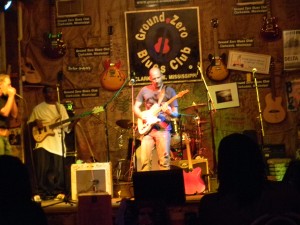 fellow his guitar for a couple of songs Anthony returned to the stage and called me up. Backed by the house drummer and bassist, I ripped through ‘Done Somebody Wrong’, ‘Goin’ Down’, and ‘Rock Me Baby’, and was quite pleased to receive a response that was somewhat over-the-top. Before leaving the stage, I announced that it was Kelly’s birthday and that we had come to Clarksdale to celebrate it, and several people applauded. As I exited the stage I got several compliments from other musicians who were waiting their turns in the wings. A few minutes later I walked over to the bar to get another beer and an older woman said to me “You were really good, but you don’t look like a blues musician.” “Blues musicians come in all shapes and sizes.” was the clarifying response I gave her before returning to my seat.
fellow his guitar for a couple of songs Anthony returned to the stage and called me up. Backed by the house drummer and bassist, I ripped through ‘Done Somebody Wrong’, ‘Goin’ Down’, and ‘Rock Me Baby’, and was quite pleased to receive a response that was somewhat over-the-top. Before leaving the stage, I announced that it was Kelly’s birthday and that we had come to Clarksdale to celebrate it, and several people applauded. As I exited the stage I got several compliments from other musicians who were waiting their turns in the wings. A few minutes later I walked over to the bar to get another beer and an older woman said to me “You were really good, but you don’t look like a blues musician.” “Blues musicians come in all shapes and sizes.” was the clarifying response I gave her before returning to my seat.
By this point we were starting to get kind of tired so we headed back to the shack. Our first day of this three-day trip drawing to a close, we sipped a beer on the back porch reminiscing our experiences. So far, this little town of Clarksdale had been a wonderful host, and we turned in for the night, excited for what Friday might bring.
Clarksdale, Mississippi – Planning our Pilgrimage
Last weekend my wife and I embarked on what turned out to be the most exciting vacation we’ve ever taken. Our three days and nights in historic Clarksdale, Mississippi, birthplace of many of America’s greatest blues artists, was as much an education on American history and culture as it was a vacation. In this small, struggling, yet proud town born in one of the darkest periods in American history, we met some of the friendliest and most soulful people you could ever meet. All the locals made us feel welcome and at home, and we also met and became friends with visitors from several other countries, as well as many other parts of the states. The experience was so massive and life enriching that I will not be able to share it in just one article, so I will spread out my writings about this adventure over several.
Several years ago my wife, Kelly, and I watched a fascinating documentary about an old Mississippi juke joint that was still continuing the traditions of ‘old-school’ Delta blues music. At the time, we talked about how great it would be to go to Mississippi and experience this tradition born out of a time and place that gave birth to so much of our favorite music. By the time we got around to exploring that possibility a couple of years later, sadly, we learned that the place had closed down. So, this year, as her birthday approached, I did a little research to see if there were any other juke joint experiences on which we could embark.
I remembered hearing something about Morgan Freeman owning a nightclub in Mississippi and, also aware of his ongoing work to preserve American roots music, this was where my research would begin. A quick Internet search revealed that he is the co-owner of “The Ground Zero Blues Club”, the namesake of this club derived from its location in Clarksdale, Mississippi, a town in which many of America’s greatest blues artists were born. Artists like Muddy Waters, John Lee Hooker, Son House, and many more. At about 300 miles from Nashville, or a 5 hour drive, the trip was easily feasible, so this idea for a birthday vacation/blues exploration became an instant hit.
When we began looking on the Internet for hotels in the Clarksdale area, we stumbled across what sounded like the perfect place to stay. “The Shack-up Inn“, located on the historic Hopson Plantation, is a series of renovated “sharecropper houses and/or tenant houses” and, after reading what must’ve been 50 or 60 glowing reviews on trip advisor, we booked a couple of nights at the shack that seemed to get the most comments, the Robert Clay shack. Among the amenities toted on the Shack Up Inn website are; AC and heat, running water – both hot and cold, indoor bathrooms, and wireless Internet “which tends to work better if you are near the lobby”. While there is a television in each of these units, the sets receive and play only one channel – Sirus radio’s Bluesville. Our particular shack would also be outfitted with a full kitchen, and old piano, and a screened in porch. The Inn also touts themselves not as a bed and breakfast, but as a “B and B” which they will tell you stands for bed and beer, as they don’t serve breakfast. Another uniqueness offered is the option of using a loner acoustic guitar, available by request in the main lobby.
In the midst of all this research we also began learning about the current live music scene of Clarksdale. While the Ground Zero blues club had some decent reviews, further digging revealed that “Reds Blues Club”, right around the corner, offers a real juke joint experience and is “the real deal”, regularly featuring some of the finest local talent. Of course this town built on such a rich history of musical heritage has plenty to see in the daytime as well. The Delta Blues Museum, Cat Head Delta Blues and Folk Art, and the Rock and Blues Museum all came up in numerous reviews as must sees in Clarksdale.
So our plan was to check in to our shack on a Thursday afternoon, attend the weekly blues jam at Ground Zero that night, explore the town on Friday, party at Reds Friday night, and leave Saturday morning for Memphis where we planned to see Graceland in the afternoon, Beale Street at night, and then spend the night at a local hotel before driving back to Nashville on Sunday. Sounds like fun, right? Well as it would turn out, fun would be the understatement of the year, and we wound up changing some of our plans at the last-minute. As you will read later, the only thing we would see in Memphis would be a view of it from our van window as we passed it on our way home.
Leaving Things Behind – What or who did you have to leave in order to chase your Nashville dreams?
The other day I was answering a questionaire for author, Wendy Willis’ upcoming book ‘Making It In Nashville‘ when one of the questions created a moment of pause – “What or who did you have to leave in order to chase your Nashville dreams?” The question was harder to answer than you might think and allowed for a great deal of reflection. As this factor is often underestimated if not ignored by those considering relocation to Nashville, I felt it was worthy of a post here.
The old saying “You never know what you have until it’s gone” is so true, and one that me and my family have come to fully understand upon relocating to Nashville. Shortly after I left my native homeland of New England I remember thinking “I’ll still be able to come home and visit once in a while. And of course I can always just call my friends and family on the phone when I miss them.” While initially this sounded like a good plan, the reality is that once you move 1300 miles away from your home, regular visits become impractical. And once those closest to you are no longer a part of your daily routines, some of these relationships can slowly begin to fragment.
Who did I have to leave to chase my Nashville dreams? When I left New England I left behind about 40 guitar students, many of whom I had been teaching for years and had become good friends. My parents and direct family, friends I had grown up with, people I played in bands with, and my wife and son’s family and friends were also rendered to essentially telephone and e-mail correspondence. You never realize how much you’ll miss these people until some time passes. Even though I do still keep in touch with my old friends and family, it’s still tough. In spite of the occasional visit back home, it’s almost as if many of them were part of another life.
What did I leave behind to chase my Nashville dreams? – Comfort, stability, my teaching career, my peers, my career as a nightclub musician, a familiar way of life, almost every relationship that ever meant anything to me, a 10 minute drive to the ocean, and all the familiar landmarks and places I had seen daily for 33 years. I also left behind harsh winters, as many bad habits as I could, and a music scene in which I could not find fulfillment. (In hindsight this lack of ‘fulfillment’ might actually have been more related to how I perceived myself than any fault of the music scene.)
The passage of time does change one’s perspective on life. It’s taken me almost a decade of working in Nashville to realize that I took a lot of things for granted in my earlier life. Nashville is a massive music industry full of opportunities that can’t be found elsewhere. While this is a good thing in some ways, it also creates an atmosphere of extreme competition, and a social atmosphere I often call ‘the land of the permanent job interview’. It wasn’t like that back home, and sometimes I miss that more carefree musical atmosphere. Most people in the Nashville music industry have an agenda and this can make it harder to find ‘real friends’. Sometimes I find myself yearning for the past, where genuine and deep relationships were more obvious.
While adjusting to the absence of all things familiar has been difficult, and I do miss my old life and friends, I am still glad I made this move. The journey has been far and wide, a life-changing experience that has taken me down many unsuspecting roads. Had I not embarked on this journey, I would not be the person I am today.
Rhett Akins at Old Threshers in Shelbina; What’s a Little Mud When You’ve Got Friends with Tractors?
This past weekend was one of the last outings of the 2010 festival season for Rhett Akins and gang. Like many things in life, outdoor festivals are like a potluck dinner – you never know what’s under the lid of that next casserole dish. That goes for not just the event itself, but to the friend and foe of every outdoor show – the weather. We’ll get to the weather debacle in a minute.
The event we would be playing on this eve was ‘The Old Threshers’ at the Shelbina Fairgrounds, in Shelbina Missouri. For those of you 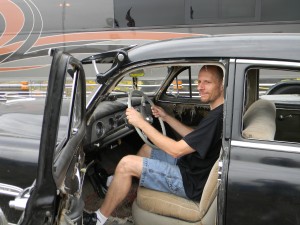 not in the know, an old threshers event is kind of a fair with a tractor theme, and this event sported some rare old beauties right out of yesteryear. After parking our bus and getting situated, we took a walk around the fairgrounds to see the sights. We didn’t get but 5 feet from the bus door when the first spectacle presented itself in the form of a 51 Chevy, the owner of which notified us that this vehicle was ours to use for the day. Who needs a runner when you’ve got a 51 Chevy at your disposal! After a few minutes of checking out and photographing this rarity, we set out on foot, camera in hand.
not in the know, an old threshers event is kind of a fair with a tractor theme, and this event sported some rare old beauties right out of yesteryear. After parking our bus and getting situated, we took a walk around the fairgrounds to see the sights. We didn’t get but 5 feet from the bus door when the first spectacle presented itself in the form of a 51 Chevy, the owner of which notified us that this vehicle was ours to use for the day. Who needs a runner when you’ve got a 51 Chevy at your disposal! After a few minutes of checking out and photographing this rarity, we set out on foot, camera in hand.
Right around the corner we stumbled upon a bluegrass band consisting of a couple of fellows on acoustic guitars, two banjo players, a woman playing a mandolin, they even had a wash tub base. They were pretty 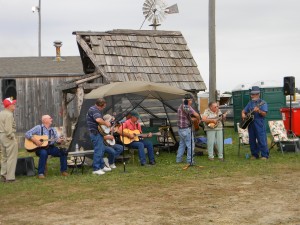 good too, and we stopped to listen for a few. It was then on to the blacksmith shop where we checked out some fine metal crafting by some locals. We dodged a few big tractors on the way over to an old schoolhouse, passing
good too, and we stopped to listen for a few. It was then on to the blacksmith shop where we checked out some fine metal crafting by some locals. We dodged a few big tractors on the way over to an old schoolhouse, passing 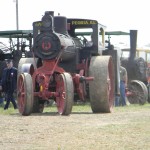 through an Amish village along the way. The old schoolhouse reeked of personality, circa late 1800s/early 1900s. As some kids were writing on the blackboard we took a look around, snapping a few more photos. This part of the day actually felt more like a class field trip than it did a gig. It was now getting to be time for load in, so we returned to the stage area to get to work.
through an Amish village along the way. The old schoolhouse reeked of personality, circa late 1800s/early 1900s. As some kids were writing on the blackboard we took a look around, snapping a few more photos. This part of the day actually felt more like a class field trip than it did a gig. It was now getting to be time for load in, so we returned to the stage area to get to work.
After our gear was loaded onto the deck, we set up and went about our sound check. Once we got it dialed in pretty good we took a few minutes to learn one of Rhett’s most recent songs, ‘Chicks, Trucks, and Beer’, a catchy little ditty with a funky beat he wrote a couple of days prior. It was then off to the hotel for showers, and this was when the weather started to go downhill. The sky grew dark, almost as black as night on the horizon, the wind picked up, and a short while later a massive downpour ensued. People were leaving in droves as we received over an inch of rain in about 45 minutes. Back on the deck, stagehands and local crew scurried to tarp the equipment, but nothing could be done to prevent the rest of this once dusty Fairgrounds from becoming one gigantic mud pit.
After the rain stopped, tractors began scraping down the mud in front of the stage. Underneath the mud was more mud, so they had to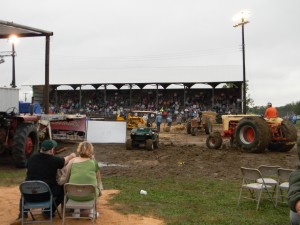 bring out bales of hay and spread straw to create acceptable conditions for the concertgoers. They also ran a series of boards for us to walk on from the stage to the bus (yes, the mud was actually that bad). Despite these obstacles we weren’t going to let a little rain and mud ruin this day, and by 7:15 the opening band ‘Little Dixie’ was taking the stage. Even though the deluge had run off a good portion of the festival attendees, there was still at least 1000 or so that stuck around for our show. At 8:15 we were off and running and about three songs in Rhett played ‘Friends with Tractors’ an obvious crowd pleaser for an
bring out bales of hay and spread straw to create acceptable conditions for the concertgoers. They also ran a series of boards for us to walk on from the stage to the bus (yes, the mud was actually that bad). Despite these obstacles we weren’t going to let a little rain and mud ruin this day, and by 7:15 the opening band ‘Little Dixie’ was taking the stage. Even though the deluge had run off a good portion of the festival attendees, there was still at least 1000 or so that stuck around for our show. At 8:15 we were off and running and about three songs in Rhett played ‘Friends with Tractors’ an obvious crowd pleaser for an 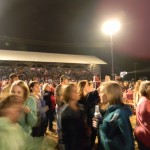 event such as this. The crowd was responsive and singing along, despite a strong prevailing wind that was a bit overbearing at times. About an hour into our show some massive lightning strikes began to appear on the horizon, so we did a couple of more songs to finish our set.
event such as this. The crowd was responsive and singing along, despite a strong prevailing wind that was a bit overbearing at times. About an hour into our show some massive lightning strikes began to appear on the horizon, so we did a couple of more songs to finish our set.
Our show complete, we tore down our gear and found our way over to the ‘Bluegrass Barn’ where the afternoon band was engaged in a little ‘pickin’ and grinnin’ after party. Rhett even sat in for a couple, leading the band through the Hank Williams classic ‘Honky-Tonkin’ and a couple of other rarities. The spirits were high, and everyone from this nice community made us feel right at home. A little while later, Steve made a mad dash with the bus across the muddy field, tires spinning every inch of the way. When we finally made it to the street, he made a big sigh of relief, perhaps having flashbacks of having to be towed out of a mud bog in Alabama earlier in the summer. Even if we had got stuck I wouldn’t have been too worried, at this show we definitely had ‘friends with tractors”. A few minutes later, and we were rolling down the highway. Thanks for making it a great event Shelbina!
Playing for free or getting paid to play; What is playing music worth to you?
Anyone who has ever gigged in Nashville knows that it is hard to make any real money by playing in the clubs around town. Aside from a very small handful of gigs that might pay $75-$100 per player, most offer minimal to no pay – some offering a base pay $20 to $30 plus tips, a lot more offer tips only (which often means essentially playing for free), and a few are even pay to play. Even on the base pay plus tips gigs quite often a player will only take home $25 or $30.
So from time to time the “playing for free” debate rears up in conversations. Some say that performing music in public for free is the only way they can gain experience, obtain exposure, make connections, and have any sort of musical life beyond practicing in the basement. Others claim that playing for free makes it harder to receive fair (or any) compensation for their services. Why would clubs and venues pay for bands and players if most will do it for free?
While both are legitimate arguments, to understand why things are the way they are I think it is important to consider the overall role of music and musical performers throughout history, not just in today’s world.
Daniel Levitin, in his book “This Is Your Brain on Music” talks about music being at the heart of human evolution.
“No known human culture now or anytime in the recorded past lacked music. Some of the oldest physical artifacts found in human and protohuman excavation sites are musical instruments.”
He continues
Even more so in non-industrialized cultures than in modern Western societies, music is and was a part of the fabric of everyday life. Only relatively recently in our own culture, 500 years or so ago, did a distinction arise that cut society in two, forming separate classes of music performers and music listeners. Throughout most of the world and for most of human history, music making was as natural an activity as breathing and walking, and everyone participated. Concert halls, dedicated to the performance of music, arose only in the last several centuries.
With that, I state my case that music has always been there and is an important and crucial part of our being. It is perhaps the earliest form of communication. Somewhere along the way this art form, this way of life, morphed into a product, or a commodity.
In the book “Muse Power: How Recreational Musicmaking Heals Depression and Other Symptoms of Modern Culture” by Cheri D. Lunn writes:
Prior to the 20th century, the concept of selling music wasn’t really commonplace. One of the very first to consider music as a marketable commodity, was Wolfgang Amadeus Mozart. “In the mid-to-late 1700s, performers and composers such as Wolfgang Amadeus Mozart began to seek commercial opportunities to market their music and performances to the general public.” (5 Wikipedia /Dear Constanze The Guardian) Before that, in more traditional cultures, the Griots, bards, and musicians were cared for by their communities, as equals in the tribe doing their part to contribute. In Europe, up until the 1700’s music was supported by patronage from the aristocracy, or the church, and so there was no need for artists to sell themselves; and so the concept of selling music had just not yet come to be.
A crucial change in the history of folk music began during the twentieth century with folk artists adopting the very western concept of “marketing for money,” or “selling” the music of the people. In this time, a new genre of popular music arose that basically became an imitation to the original traditions of folk music as it was sung by ordinary people. These “folk” artists marketed themselves alongside more popular and modern emerging artists and created a niche for themselves by performing traditional music and songs in amplified concerts, and disseminating their work by recordings and broadcasting.
But along with the commercialization of music and musical performers, especially now in the digital age, comes somewhat of a desensitization to music, or what I call a ‘dumbing down’ of the masses in this regard. In today’s world, music is heard everywhere – from traditional advertising like TV and radio commercials to ring tones and ring backs, from video games to iPods, today’s Internet generation is saturated with digital music overload. In many situations, recorded music is now free, and with the advent of software like garage band, millions can now make homemade recordings to further flood the airwaves. In the midst of this oversaturation, TV shows like “American Idol”, “Nashville Star”, and “America’s Got Talent” have perpetuated the false reality that the masses can also now obtain superstardom.
Put all this together, and you’ve got more people than ever trying to get into the “music business”. But as millions more each year try to enter this world, the opportunities for them will inevitably shrink. There are only so many bars and nightclubs that need live music.
If you consider this history, it is fair to say that the concept of being paid for your music, or paid to play your music, is relatively new and largely an invention of our modern capitalistic society. Don’t get me wrong, I’m not suggesting we abandon this concept, this is how I am currently earning the bulk of my living. What I am suggesting is that the evolution of the paid musical performer may have been accidental, and is not necessarily a sustainable vocation in this modern world.
Music belongs to everybody. We need to better understand the role that music has played in our history, and how the cultivation of music as a part of our culture can benefit our world as well as the futures of our children. Does our future hold a world in which musical performers are paid for their ‘services’, or will the performance of music one day return to something that is shared by everybody? Did society really benefit when music was turned into a product? Do we deserve to be “paid to play”? I don’t know if I’ll always be able to earn a living from music, but even if one day I can’t, I’ll always play music, doing so enriches my life.
What is music, and the art of performing it worth to you?
Does Practice Make Perfect?
When I was 12 years old I was inspired to learn how to play the guitar after hearing the music of Jimi Hendrix. As I began learning, I quickly realized I would have to put a lot of effort into this endeavor to be able to make the kind of music that Jimi inspired me to make. So I dug in, and the more I dug in and applied myself, the better I became at my craft. As I got better, it started to become more fun too. Early on I made the connection that the more I applied myself (by practicing, wood shedding, experimenting, etc.) the more I enjoyed guitar playing. For me, practicing my guitar, and enjoying the act of guitar playing go hand-in-hand, and I never viewed practicing as a chore I had to do.
As the years churned on I never stopped applying myself. I eventually went to Berklee, began playing professionally, and still work at improving and honing my skills 20 years later (even though I can maintain a decent level of proficiency without doing so). While some people along the way have suggested that I practice more than I need to, I disagree. Putting in such a big effort over a long period of time has not only made me a better musician, it’s made me a better person. It’s benefited my life in ways that go way beyond music. If you can teach yourself self-discipline through the mastery of your craft, you will forever have an increased self-discipline in every facet of your life, more patience, problem-solving skills, the list goes on.
In my opinion, too many musicians coming up in the world today learn a bare minimum of proficiency early on and then just coast. So many are consumed by aspirations of fame and fortune that they miss out on the rewarding feeling one can get from just working towards being great at something. Whether you you play music as a career or just for fun, I believe that the more you put into developing your craft, the better your whole life will be. Practice might not make you perfect, but it will make you better.
My interview with the record company dude
Last week I posted a blog in which I asked you (the reader) what questions you would ask somebody from a record label if you had access. That blog prompted some pretty interesting questions, and when I conducted my interview today with EJ Bernas, Senior Director of Southwest region of Universal Music Group, those questions made up the bulk of what I asked him. The interview was lengthy and informative, and a lot of work lies ahead (transcribing, editing, proofing, etc.) before this fascinating conversation will be print ready. So for now, I would just like  to share a few high points of this unique experience.
to share a few high points of this unique experience.
I arrived in downtown Nashville just before 1 PM and found a parking spot in front of the Bridgestone arena. After feeding some quarters into the meter (three dollars only got me two hours) I walked a couple of blocks over to the UMG headquarters, located on Commerce street. After taking the elevator to one of the top floors of an otherwise unsuspecting office building, I emerged into the lobby and found my way to the receptionist. The friendly young lady informed EJ that I had arrived, and a moment later he came out to meet me. We retreated into a large comfortable conference room which had a spectacular view of downtown Nashville.
 I could write an entire article just about what I saw in those few short seconds gazing out that window. The roof of the Ryman Auditorium just below us, the hustle and bustle of people milling about on Broadway, the Bridgestone arena, the controversial new skyscraper still being constructed, the Cumberland River in the distance – a city truly alive in so many ways. Behind every window of the hundreds of buildings visible from this spot was a story. For every car that passed by on the streets below, another story. Some say that this is a city built on dreams, and from this vantage point I could literally feel that kind of intangible element that fuels such a mysterious place.
I could write an entire article just about what I saw in those few short seconds gazing out that window. The roof of the Ryman Auditorium just below us, the hustle and bustle of people milling about on Broadway, the Bridgestone arena, the controversial new skyscraper still being constructed, the Cumberland River in the distance – a city truly alive in so many ways. Behind every window of the hundreds of buildings visible from this spot was a story. For every car that passed by on the streets below, another story. Some say that this is a city built on dreams, and from this vantage point I could literally feel that kind of intangible element that fuels such a mysterious place.
“This is an amazing view. Do you have a view this cool from your office too?” I asked. “You bet, my office is right next door. You can see the roof of the old church (Ryman) below” he said as we both gazed across the vast expanse. With that, we each took a comfortable spot at the table and dug into an hour and a half discussion about the state of the recording industry, radio, and how today’s aspiring artists fits into that world (at times the discussion became more like how the recording industry and radio fit into the world of the aspiring artist.) Like I said,  the contents of this interview still need to be transcribed and reviewed before I can share any of it, so for now you’ll have to just settle for me simply bragging about this day.
the contents of this interview still need to be transcribed and reviewed before I can share any of it, so for now you’ll have to just settle for me simply bragging about this day.
At one point during the interview, EJ’s boss walked through the room and I received a brief introduction. A little while later another man walked through, and I was again introduced, this time to the head of A&R. EJ explained to me that UMG (Universal Music Group) consists of MCA, Mercury, and Lost Highway Records and represents artists like Billy Currington, Julianne Hough, Reba McEntire, Randy Rogers Band, George Strait, Sugarland, Jamey Johnson, Josh Turner and Shania Twain, among others. Even though I’m not aspiring for any sort of success as a radio star, it did occur to me just how fortunate I am to know someone like EJ – a warm and open individual gracious enough to give this glimpse into a world in which so many aspire, yet so few ever travel.
After the interview was over, he walked me back out to the lobby where I had the receptionist snap a quick picture of the two of us. I thanked him again and made my way back to my car. It was definitely a learning experience for me and I know this interview will add much valuable perspective to all the aspiring artists and musicians who will eventually read it. Thanks again EJ for making my day, and my book.

Rhett Akins Plays Balloons, Tunes and BBQ Festival in Bowling Green Kentucky
Saturday night’s show at the U.S. Bank Balloons, Tunes and BBQ Festival in Bowling Green Kentucky turned out to be a huge success, but earlier in the day things were looking pretty bleak. All week long the weather forecast showed a strong possibility of severe weather for this area, as the remnants of Tropical Storm Hermine were projected to move through. When we arrived on site at the Warren County Regional Airport a strong steady wind was already blowing, despite an otherwise beautiful sunny day.
Right around the time we were about to start micing up our instruments for soundcheck, the sky grew ominously dark, and a few minutes later a strong gust of wind knocked over a large column of PA speakers. Fortunately, nobody got hurt, but it was a frightful moment. As a downpour was imminent, we quickly scrambled to put tarps over our stage gear. Minutes later we watched from the bus window as a strong steady rain pummeled the airport grounds. Just when we thought our day was completely doomed the rain subsided, and a short while later the sun returned to dry out the rain soaked grounds.
 As it turns out, we got real lucky and it never did rain again. The first two days of the festival had been a complete washout due to the weather, but by late afternoon the winds had died down, and some hot air balloons began to permeate the sky for the first time on this weekend. By the time the first group, Easy Street, went on stage at 5:30 there was already a couple of thousand people in front of the large mobile stage, and their set was well received. A little while later, after the second band, Floord, was finished with their set, Nick Hoffman (Kenny Chesney’s fiddle player) took the stage with his band. During Nick’ set I organized and led a large meet and greet backstage with some radio station contest winners who were more than excited to meet Rhett.
As it turns out, we got real lucky and it never did rain again. The first two days of the festival had been a complete washout due to the weather, but by late afternoon the winds had died down, and some hot air balloons began to permeate the sky for the first time on this weekend. By the time the first group, Easy Street, went on stage at 5:30 there was already a couple of thousand people in front of the large mobile stage, and their set was well received. A little while later, after the second band, Floord, was finished with their set, Nick Hoffman (Kenny Chesney’s fiddle player) took the stage with his band. During Nick’ set I organized and led a large meet and greet backstage with some radio station contest winners who were more than excited to meet Rhett.
At about 8:45 it was finally our turn for some stage time, the crowd had now swelled to around 10,000, and was at the peak of this annual  event’s outing. We dug in hard for a rockin’ 90 minute show, the crowd into it from the onset. About halfway through our show, Rhett brought up his son, Thomas Rhett to sing the soon-to-be classic ‘Duck Blind’. After this well received rendition, a woman somewhere near the front row yelled out “He’s real sexy too!” This helped prompt Rhett to prod young Thomas into doing one more song, ‘Tobacco’, one of Thomas’s original compositions which he performed solo acoustic. Apparently, Thomas takes after his dad, who bragged about his son’s first cut as a songwriter on Jason Aldeans’ latest album, and the fact that “Some day soon you’re going to be hearing Thomas Rhett on the radio too!” After Thomas left the stage to a roaring applause, we continued on with our set, and a little while later Rhett invited up Nick Hoffman to sit in for a couple of tunes on the fiddle. Rhett ended the show by playing a solo acoustic version of “Gimme That Girl” the blockbuster hit he wrote for Joe Nichols. This soft and soulful piece helped to wind down the electricity in the crowd, and upon its conclusion they began to slowly exit the concert grounds.
event’s outing. We dug in hard for a rockin’ 90 minute show, the crowd into it from the onset. About halfway through our show, Rhett brought up his son, Thomas Rhett to sing the soon-to-be classic ‘Duck Blind’. After this well received rendition, a woman somewhere near the front row yelled out “He’s real sexy too!” This helped prompt Rhett to prod young Thomas into doing one more song, ‘Tobacco’, one of Thomas’s original compositions which he performed solo acoustic. Apparently, Thomas takes after his dad, who bragged about his son’s first cut as a songwriter on Jason Aldeans’ latest album, and the fact that “Some day soon you’re going to be hearing Thomas Rhett on the radio too!” After Thomas left the stage to a roaring applause, we continued on with our set, and a little while later Rhett invited up Nick Hoffman to sit in for a couple of tunes on the fiddle. Rhett ended the show by playing a solo acoustic version of “Gimme That Girl” the blockbuster hit he wrote for Joe Nichols. This soft and soulful piece helped to wind down the electricity in the crowd, and upon its conclusion they began to slowly exit the concert grounds.
 It was a long day, but a good day, and we were all thrilled that the weather wound up being on our side. While this isn’t always the case with these kinds of outdoor shows, past experience has taught me to always hope for the best, while preparing for the worst. We’ve got two more outdoor shows on the books in the upcoming weeks. Hopefully, we’ll get lucky on those too!
It was a long day, but a good day, and we were all thrilled that the weather wound up being on our side. While this isn’t always the case with these kinds of outdoor shows, past experience has taught me to always hope for the best, while preparing for the worst. We’ve got two more outdoor shows on the books in the upcoming weeks. Hopefully, we’ll get lucky on those too!



